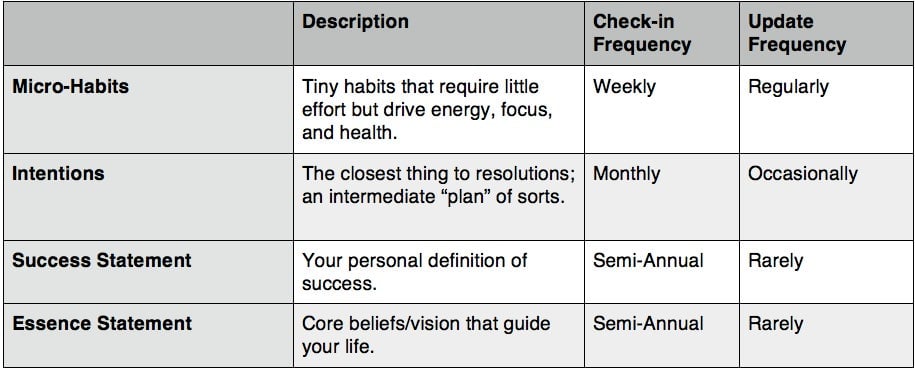Don’t set goals for yourself—instead, create systems that make it easy for you to succeed
A lot of my friends are spending the month of January “going dry” or giving up sugar or training for marathons. I can relate. As a Type-A, goal-oriented masochist, I tend to make deeply ambitious New Year’s resolutions each year. Witness Exhibit A: My resolutions from 2016. I’m embarrassed to say that not one lasted even a month. (That’s what you get when you resolve to limit dessert in terms of “units per week.”)


A lot of my friends are spending the month of January “going dry” or giving up sugar or training for marathons. I can relate. As a Type-A, goal-oriented masochist, I tend to make deeply ambitious New Year’s resolutions each year. Witness Exhibit A: My resolutions from 2016. I’m embarrassed to say that not one lasted even a month. (That’s what you get when you resolve to limit dessert in terms of “units per week.”)
So this year, I decided to give up on making resolutions altogether. Instead, I devised my own system to help me lead a life that’s in keeping with my values. I call it my Intentionality Dashboard.
I created the dashboard because I’d found that it was hard to stick to goals like “eat healthier” or “exercise more” on their own; to make these kinds of changes, I needed a specific plan of action. And as Dilbert creator Scott Adams explains on his blog, we’re actually much more likely to succeed in changing our habits when we use systems instead of goals. After all, goals tend to be somewhat constricted—say, “lose 10 pounds” or “beat my marathon record”—when it makes more sense to focus on holistically building a better life.
So I set about creating a system, using the project management app Trello, that would give me a bigger, birds-eye view of how I live my life. To design it, I broke it into four sections: Two focused on big-picture issues, and two that dealt with concrete changes. The basic idea was that with a system that was actionable, yet not overwhelming, I could generate a lot of “small wins” on a daily basis—providing momentum for much bigger projects.
The four points of the Intentionality dashboard are listed below:

I’ve set this dashboard up as a public template in Trello. Feel free to follow along here, and click on individual cards to see additional information. If you’re interested in setting up your own, here’s how to do it for yourself.
Micro-habits
Micro-habits are the small, simple changes you can make with relative ease. I strongly believe that noticing and tuning the small behaviors that make you feel better can greatly influence your life more generally. To use a car analogy, think of micro-habits as the oil and the gas in your automobile. On their own, they’re useless. But if you want to get to your destination, you’re gonna need them. Micro-habits can be both positive (Get more sleep) or negative (Snack less in the afternoon).
I thought about my micro-habits along the following categories: focus, energy, fitness, and nutrition. An example of a fitness micro-habit is “Eat less heavy lunches; they drain me of my energy.” (This is a byproduct of most of my lunches being business-oriented—in other words, often at restaurants with elaborate, delicious menus.) Now, it’s not enough to just list the habit I want to change. I need to tie it to a specific plan: a micro-plan. So to combat my urge to eat a bacon cheeseburger when I’m out to lunch, I’m going to make it a habit of ordering an appetizer and a salad as an entrée.
The micro-plan can also address things that hold you back. For example, “Improve quality of sleep” is paired with “Buy a physical alarm clock and keep iPhone out of bedroom.”
Intentions
Next, I designed my “Intentions.” These resemble goals or resolutions. They’re bigger and more complex than micro-habits, but change less frequently. As with micro-habits, they come with an added, specific plan, and they involve tackling bigger projects than the previous category. I decided to set intentions for my personal life and my work life. For example:
- Develop unique ideas: Read fewer blog posts and more physical books—particularly books that have been read by few people. Commit to tying together interdisciplinary ideas through journal entries.
- Write a book: Commit one or two of my most productive hours (for me, that’s the morning) to working on a book, and prioritize the rest of my day around this activity.
Success statement
The next layer is more personal. For context, during most of my adult career, I believed that my happiness would come from external metrics, notably money and status. This narrative is prevalent in many people’s professional lives, despite lots of evidence pointing to intrinsic factors being the most driver of happiness and fulfillment.
But as I got older, my ideas of success changed. I understood that I still needed enough money to meet my family’s basic needs. But beyond that, I wanted to put a lot more emphasis on my sense of purpose, the people I spent time with, and my hobbies and passions.
That said, living in New York City, I often have to remind myself not to compare myself to my peers. Recently, I saw a neighbor’s Mercedes SUV in our parking lot and felt a deep pang of disappointment that we didn’t have one. I worried that our lack of a Mercedes meant that I somehow wasn’t living up to my full potential.
That experience reminded me that it’s important to actively articulate what makes my family and me happy. What would success look like for us over the next few years?
Using the categories of “work” and “personal life,” I came up with a success statement. These included:
- Be surrounded by kind, smart, diverse, and energy-giving folks
- Belong to work environment in which I don’t need to respond to messages immediately, giving myself time to think
- Be creative every day
- Spend money on high-quality family experiences, not on accumulating stuff
This list is much smaller, more aspirational, and shouldn’t change too frequently. After all, your definition of success likely doesn’t change every couple of months. But it’s worth writing down, to remind yourself of what’s important, and reviewing every so often as your life circumstances change (new career, new kid, and the like).
Essence statement
Last of all is the essence statement. Some might call these values, but I’ve found it difficult to pick a few virtues that represent me holistically. Instead, I’ve selected a few beliefs that best reflect my life philosophy. Like anything on this list, this section can and should change over time. But it’s probably less likely to be affected by external events.
The essence statement is useful because, as you live your life, you will inevitably be confronted with larger and more complex decisions. They could be personal (what to do about a tiff with a family member) or professional (should I accept my company’s offer to relocate?). The essence statement helps you locate your True North. When you’ve taken the time to lay out your key beliefs with a clear mind, you’ll be in a better place to make decisions in fast-moving or complex situations.
This part of the system definitely requires some time and reflection, so don’t beat yourself up if they don’t come to you right away. Mine are as follows:
- My family comes first, but I must also take care of myself to be at my best for them
- Give without expecting anything in return
- Compound small acts (knowledge, relationships, investing) over time and optimize for the long term
- Be compassionate and authentically vulnerable
- Leave your comfort zone frequently, but not out of fear
- When you’re with someone, give them 100% of yourself
I plan on using this Trello board as a living document—one that I’ll check in on regularly.
As I outlined in the table above, I’ll check in with myself on the micro-habits once a week. These are the most dynamic and I think it’s healthy to cull them, modify them, and be honest with myself if they’re not working out.
I’d like to look at the intentions on a monthly basis, mostly to see if I’m on track. The success and essence statements shouldn’t change often. But I’ll have them stored in an easily locatable spot so I can remember to stay true to them.
I’m excited about this new system because it’s a way to prompt myself to reflect on some of life’s larger questions. As the futurist and author Joel Barker says: “Vision without action is merely a dream. Action without vision just passes the time. Vision with action can change the world.”